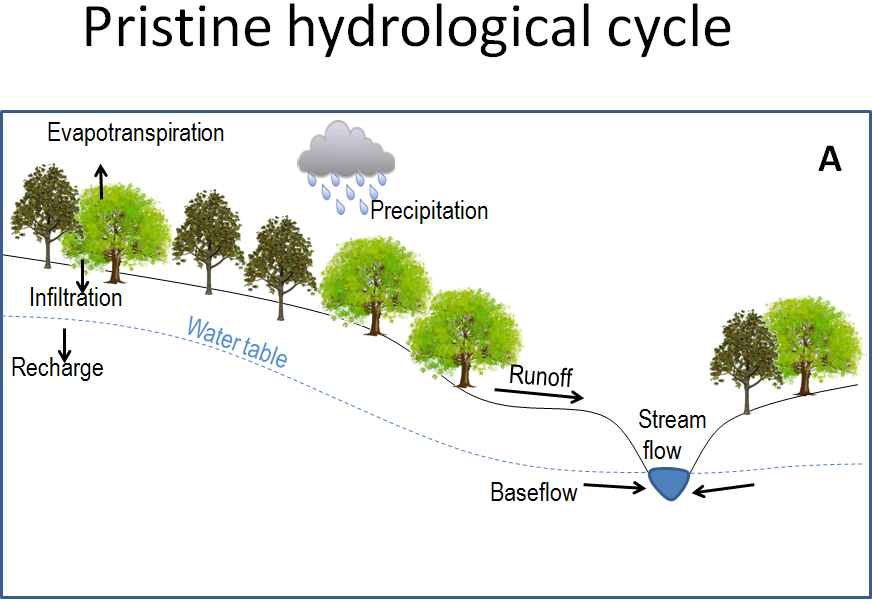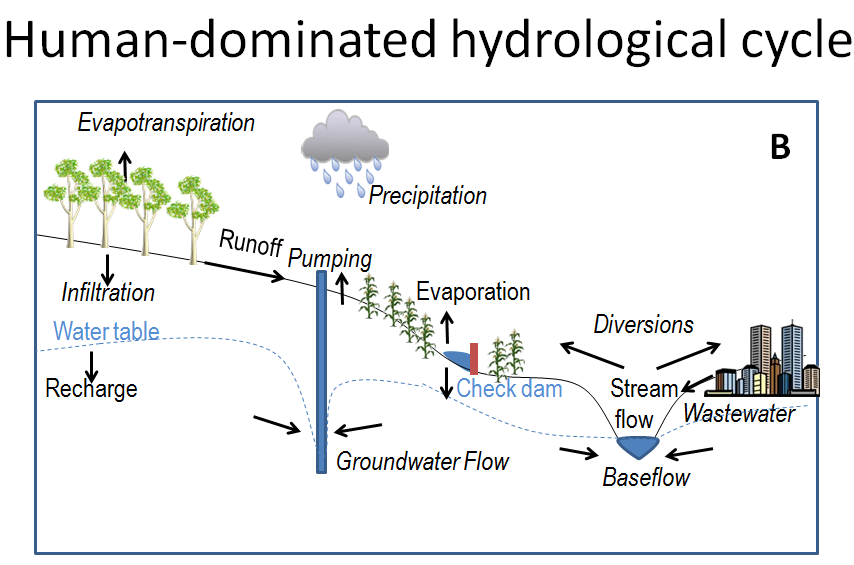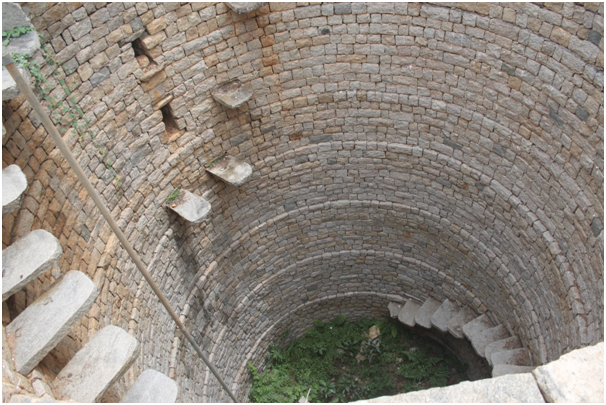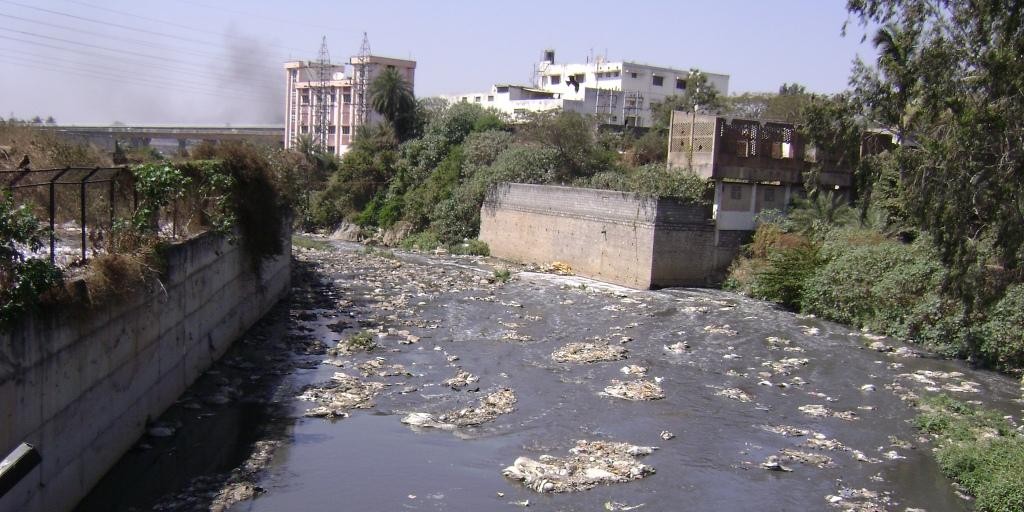Bring up the topic of water, and you are bound to get everybody’s attention and probably a heated discussion going. Water is a part of our lives in so many different ways: not just for survival activities of drinking or cooking, but also in the production of our food, in many industrial activities, and even as a carrier of our waste. And in India, as in many other densely populated and rapidly industrialising sub-tropical regions, water scarcity, water pollution and too much water (flooding) are all major societal challenges. Responding to these challenges properly requires understanding how water is the quintessential environmental public good, and what kind of public actions may be required.
The physical side: flows, connectivity, and return flows
It is useful to start with some clarifications of the physical side of the story, i.e., the hydrological cycle. The terrestrial portion of the hydrological cycle and how it changes under human-dominated conditions is shown in Figure 1. The first point to note is that water is a ‘flow’ resource. It moves all the time—over land, through soil and through plant systems—and makes its way back to the atmosphere through evaporation or transpiration to come back (somewhere) in the form of rain/snow.
Second, the only ‘consumptive’ use of water is that which results in evaporation or transpiration. Indeed, the major human intervention in the hydrological cycle is through increased transpiration from irrigated agriculture, leading to a shortening of the cycle—the water evaporates before it reaches the oceans. Most of the other uses are non-consumptive but polluting—water is released back into streams, but in a more or less polluted form (see right side of Figure 1-B).


Third, groundwater is nothing but rainwater that infiltrated and made it past the roots of vegetation (=recharge), and since what goes in must come out at some point, recharge eventually shows up as baseflow contributions (=discharge) to streams and rivers, or even directly to oceans. This means that any extraction of groundwater reduces river flows or discharges to the ocean (see left side of Figure 1-B). Similarly, any effort to ‘augment’ groundwater by, for instance, building check dams only repartitions water flows from surface to ground. Rooftop rainwater harvesting captures water earlier, also reducing surface flows. In other words, it is not possible to create ‘new water’, except through desalination, which is an enormously energy-intensive technology.
Fourth, the remaining part of the hydrological cycle is also important. Rivers eventually empty into oceans, from which the water evaporates to form clouds, which, in the Indian case, bring rain to the subcontinent. It is inappropriate to think of that water as ‘waste’—the estuaries at the mouths of rivers where sweet water mixes with salt water are enormously productive ecosystems with some of the richest fisheries.
Decision-making in the water sector is dominated by engineers who think any water going to the sea is a waste, who are blind to the social costs of large dam projects, and who focus on building sewage treatment plants but not on the sewerage network required to bring sewage to the plant.
These physical features of the hydrological cycle have major implications for how we think about and organise the use of water. They tell us that water is a quintessential ‘public good’ which cannot be privatised. One may think that a Bisleri bottle or a tanker is a privatised form of water, but that is only temporary. Eventually it flows through our toilets back to the ecosystem downstream, and the extraction of that Bisleriwater also affected someone else using water from the aquifer. In other words, water is a common-pool resource that links upstream to downstream. And all forms of storage and diversion, large or small, create not only downstream impacts but also impacts through submergence and land loss, ecosystem changes, and so on. Thus, water management requires ‘public institutions’ that regulate allocation at the scale of the resource to address the core allocation questions: Who should use how much water at whose expense? And who may release how much effluent where and at what quality? How should allocations be made between surface and groundwater users, if they are part of the same cycle? And the work of these public institutions must be underpinned by rigorous, multi-disciplinary and ‘public’ science, i.e., science that transparent to the public.
Indian situation: non-transparent science, ‘care’-less engineering, weak institutions
Unfortunately, the situation in India as regards to this common pool resource is rather discouraging at the moment. Alarming rates of groundwater depletion are only matched by equally alarming levels of water pollution in rivers and declining flows in the rivers. While the social impacts of groundwater overuse will be felt in the future, the indirect impacts in terms of increasing electricity consumption and indebtedness of farmers who spend on drilling borewells that fail are already visible. While average water supply in many cities appears quite adequate on paper, high leakages and inequitable distribution create pockets of high scarcity, with the poor often paying the highest rates per litre. And the socio-environmental costs of large dams are visible everywhere.

Figure 2. The open wells have dried up in most parts of peninsular India, where borewell pumping has lowered the water table drastically (Photograph by: Kirubaharan Jeremiah).
The reasons for this situation are several, but a common thread is the non-recognition of the public good nature of the resource and of the need for public institutions and public science and socially sensitive engineering. On the science side, groundwater monitoring agencies set pumping limits without considering the impacts on surface flows. And their data are largely not in the public domain and not subjected to rigorous scientific analysis. The hard-rock aquifers of peninsular India present a particularly daunting challenge in this regard, but the scientific effort in this regard has been very limited. Similarly, flows in most rivers are either not monitored or the data are not accessible to the public, thereby preventing rigorous analysis for understanding the impacts of human intervention.

Figure 3. Most rivers near cities have become sewers: the Vrishabhavathy river in Bangalore (Photograph by: Priyanka Jamwal)
Decision-making in the water sector is dominated by engineers who think any water going to the sea is a waste, who are blind to the social costs of large dam projects, and who focus on building sewage treatment plants but not on the sewerage network required to bring sewage to the plant, nor do they address the operation and maintenance challenges faced by these plants or by irrigation canals.
A new generation of scientists is also emerging that wants to tackle socially-relevant hydrological questions.
Our regulatory institutions are weak (in the case of surface water) and non-existent (in the case of groundwater). Pollution control board officials are bogged down in paperwork and spend little time monitoring pollution in the field; corruption is a constant presence. In structuring these agencies, the issue of transparency and downward accountability to water users or potential pollutees has been given the go-by: the governing boards of all these agencies are stacked with bureaucrats who keep rotating and their CEOs are officers on short-term deputation from other departments. River water dispute tribunals struggle to meet the workload with very limited access to data or high-quality science.
Emerging movements and opportunities
Despite this daunting picture, citizens’ movements are emerging across the country in various forms and shapes to make a difference. At the simplest do-it-yourself level, urban citizens are setting up networks to measure and publicly share city-wide rainfall patterns. Corporates are teaming up with NGOs to reduce their water footprint and improve water budgeting. But citizen groups are also putting pressure on municipal agencies to rejuvenate lakes and offering their time for monitoring and maintenance. In a few villages such as Hivre Bazar in Maharashtra, the gram sabha has banned the digging of borewells and imposes restrictions on area irrigated during a drought year. In other regions, movements for river rejuvenation and maintenance of ecosystem flows have caught on. Groups are petitioning the National Green Tribunal to prevent further diversions of river waters or appropriation of waterfront lands. A new generation of scientists is also emerging that wants to tackle socially-relevant hydrological questions.
Water is too important a subject to be left to engineers and bureaucrats alone. It is a public good problem that will require broad-based public engagement and the building up of a groundswell of opinion that will enable some difficult choices and innovative solutions.
These movements also represent an opportunity for innovators: technological and social ones. For instance, there is enormous need for cheap instruments for automatic monitoring of deep groundwater. As also instruments for measuring stream and river flows, monitoring pumping rates from borewells, and sensing water quality at factory outlets and in-stream. Similarly, there is space to innovate different models of domestic sewage treatment and disposal, including linking farmers to the sellers of sludge, linking neighbourhood parks to sellers of treated water, and so on. Such opportunities will expand as the pressure grows for lasting, environmentally sound and socially fair solutions for our water problems. Water is too important a subject to be left to engineers and bureaucrats alone. It is a public good problem that will require broad-based public engagement and the building up of a groundswell of opinion that will enable some difficult choices and innovative solutions.